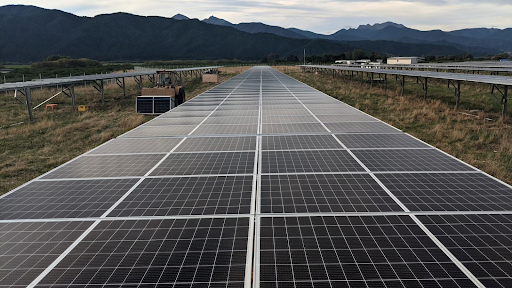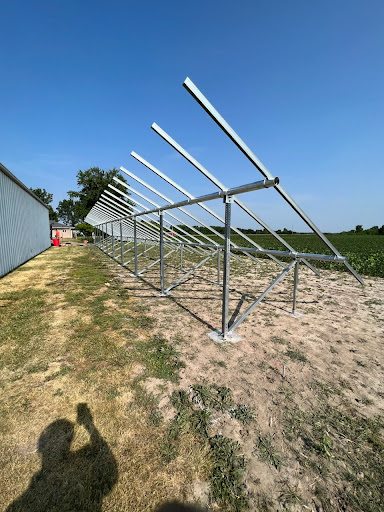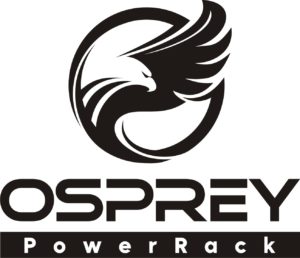Ballast Foundation For Solar: Costs, Use Cases, Pros & Cons
Key Takeaways
- Ballast foundations are commonly used for installations on flat roofs.
- They provide flexibility and are less intrusive, which makes them suitable for temporary setups.
- Alternatives include driven piles, helical piles, and earth anchors.
- Nuance Energy’s earth anchor foundation is easier to install and generally suitable for all soil types.
What Is Ballast Foundation For Solar
A ballast foundation uses heavy materials, such as concrete blocks or loose stones to stabilize the solar arrays without the need for drilling into the ground.
It is commonly used in areas where soil conditions are unsuitable for traditional foundations or where regulations prohibit ground penetration.
| Nuance Energy is your superior solution for Ground Mount solar. Our patented foundation technology, in the Osprey PowerRack™, allows for rapid installation using only handheld tools, significantly reducing both time and costs compared to traditional racking systems. This cutting-edge technology works for residential and commercial installations, and Nuance Energy empowers solar installers to take back control of their installation schedules, control project COGS, gain market share, increase the speed of installation, and reduce costs and labor. In contrast, a traditional ground mount is much more unpredictable, slower, and costly.
Find out how Nuance Energy can accelerate your solar projects with the Osprey PowerRack™ line, and boost your profitability. Contact us today to discuss our innovative ground-mount solutions. |
Costs Of Ballast Foundation
The total cost of installing a ballast foundation usually ranges from $0.50 to $2.00 per watt for the entire solar installation, including the ballast system. This translates to approximately $15,000 to $60,000 for a standard 30 kW solar array.
Factors Affecting the Cost of Ballast Foundations
- Size of the Solar System: The scale directly influences the number of ballasts needed and the complexity of installation.
- Material Costs: The type of ballast material (e.g., concrete blocks, stones) significantly affects costs. Precast concrete is commonly used, but innovative solutions like quarry rock or recycled materials can drive up costs.
- Installation Location: Difficult-to-reach areas or locations with challenging terrain may incur higher labor and transportation costs.
- Labor Costs: While ballast systems are generally quicker to install than penetrative systems, skilled labor is still necessary for proper weight distribution and stability.
- Geotechnical Conditions: Sites with poor soil conditions may require additional engineering assessments or modifications. Pull tests to determine soil resistance can add $6,000 to $20,000 to project expenses.
- Regulatory Compliance: Local building codes and regulations can influence design choices and installation methods, which leads to increased costs if special permits or inspections are required.
* The pricing was estimated at the time of this writing and is subject to change in the future.
Pros Of Ballast Foundation

Ballast foundation for solar has a higher upfront cost but can be more cost-effective in the long run.
- Non-Penetrative Installation: Ballast systems do not require drilling into the ground, which makes them suitable for sites where soil disturbance is undesirable, such as contaminated land or areas with fragile ecosystems.
- Quick Installation: The installation process is generally faster than traditional methods, as it does not involve extensive groundwork or heavy machinery. This can lead to reduced labor costs and quicker project completion times.
- Stability and Weight: Ballasts provide sufficient weight to stabilize solar panels against wind uplift and other forces. They can also help mitigate the impact of seismic activity.
- Drainage and Flood Prevention: Ballast systems allow for natural drainage, which can prevent flooding in solar farmland.
- Flexibility: These systems can be laid directly on various surfaces, including hard ground or roofs, and can be easily adjusted or relocated if necessary.
- Cost-Effectiveness: While initial costs may be higher (approximately 25% more than traditional foundations), the reduced labor and maintenance costs can make ballast more cost-effective in the long run.
- Environmental Impact: Ballast foundations minimize soil disruption so they’re more sustainable.
Cons Of Ballast Foundation
- Soil Compaction: The weight of the ballast can lead to soil compaction, which may negatively affect plant growth in agrivoltaic areas.
- Space Requirements: Ballast systems require more land area than penetrating foundations.
- Material Durability: Since materials like concrete can degrade due to environmental factors such as UV exposure and freeze-thaw cycles, replacements may become necessary.
Use Cases Of Ballast Foundation
- Flat Roof Installations: Suitable for securing solar panels on flat roofs.
- Utility-Scale Solar Farms: Suitable for large solar arrays where traditional foundations may be impractical or too costly.
- Contaminated Sites: Used for installations on brownfields or landfills, where disturbing the soil is not allowed.
- Moist or Wet Areas: Applicable in locations with high moisture levels where ground penetration is challenging.
- Temporary Installations: Facilitates easy assembly and disassembly for short-term solar projects or events.
- Areas with High Wind Load Requirements: Provides stability in regions prone to high winds.
- Sites with Frost Heave Concerns: Effective in areas where soil movement due to frost heave is a concern, as they can adapt to ground movement without structural damage.
Earth Anchor Foundation By Nuance Energy

Nuance Energy’s patented earth anchor foundation can be installed with minimal site disruption.
Our earth anchor foundation used in our flagship racking system Osprey PowerRack™ has several advantages over ballast foundations:
- Faster Installation: A small crew (3-4 people) can assemble a 10 kW structure in about an hour. Ballast foundations can take longer due to the handling and placement of heavy materials.
- No Geotechnical Reports Needed: Our Osprey PowerRack™ system has real-time soil condition anchor “load testing” so there’s no need for soil assessments, unlike with ballast systems.
- Minimal Site Preparation: This foundation requires little to no site grading or preparation, which makes it suitable for challenging terrains or areas with hard soil conditions.
- No Environmental Impact: The earth anchor system minimizes disturbance to the land compared to ballast foundations, which can compact soil and affect ecosystems.
Frequently Asked Questions (FAQs)
Where are ballast foundations best suited?
- Flat Roof Installations: They provide a secure mounting option without compromising roof integrity.
- Contaminated Sites: Locations where traditional methods would be impractical.
- Utility-Scale Solar Farms: They stabilize large arrays without extensive grading or site preparation.
- Agrivoltaics: Systems where solar panels coexist with agricultural activities to minimize soil disruption.
What is the lifespan of a ballast foundation?
Generally, these systems are designed to last as long as the solar panels themselves – 20 to 25 years.
What maintenance is required for ballast foundations?
- Checking for any signs of wear or degradation in the ballast materials.
- Managing vegetation growth around the ballasts to prevent interference with solar panel performance.
- Checking that all ballasts remain securely in place and that no shifting has occurred over time.
Are there alternatives to ballast foundations?
Yes, alternatives include:
- Driven Piles: These penetrate the ground and are suitable for various soil conditions but require heavy machinery.
- Helical Piles: These are screw-like foundations that also penetrate the ground but are effective in many soil types.
- Earth anchors: These are driven into the ground with only handheld tools and are generally suitable for all soil types.
How does the earth anchor foundation work?
The earth anchor foundation uses anchors that are driven into the ground – but don’t need concrete or heavy equipment. This technology provides stability and support for solar panels while minimizing site disturbance.
Save Time & Money on Your Next Solar Project
Request a QuoteRECENT POSTS
- DPW Solar vs Nuance Energy Mounted Solar Options: Cost & Benefits
- Geotechnical Report Cost & Requirements For Solar Projects
- Are Solar Panels Worth It In Nevada? Costs & Options
- OSPREY PowerRack Ground Mount System Compatibility: Single- and Dual-Axis Trackers
- Rammed Earth Foundation For Solar Arrays: Cost, Pros & Cons
- Agrivoltaics Explained: Solar & Agriculture Combined
- Large Scale Solar Systems Options: Pros & Cons
- Best Solar Options For Farms & Agriculture: Cost, Pros & Cons
- Unirac vs MT Solar Mounted Options: Cost & Benefits
- IronRidge vs Grengy Mounted Solar Options: Cost & Benefits

